|
"I Got Dem Low Down Malta
Blues..."
by Steven "Modeldad" Eisenman
|
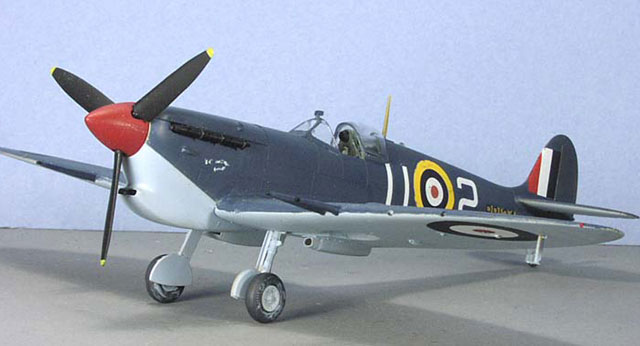 |
|
Malta Spitfire |

Tamiya's 1/48 scale Spitfire Mk.Vb is
available online from Squadron
On HyperScale’s Plane Talking Discussion Group we
often speculate about the color of a particular aircraft, or whether or
not such and such camouflage pattern was used. But, we frequently avoid
finishing models in those speculative color schemes. Could the reason be
that we don’t want to waste a good kit on a speculative scheme, or that
that we don’t want a friend walking into our house and telling us how
wrong it is?
Having a stash of 1/48 kits that is larger than any hobby shop in my area,
and having no one who sees my models who would know the difference between
Temperate Land Scheme and Temperate Sea Scheme, or know that a Finnish
aircraft is not a Nazi, I guess I have the freedom to do some odd ball
stuff.
For years the color of the “Malta Blue Spitfires” has
been debated on Plane Talking. What was the actual color? What paint did
they use or could have used? U.S. Navy paints, Extra Dark Sea Gray, Dark
or Light Mediterranean Blue, or was it a local mix that will forever be
unknown?
Rather than try to solve all the questions, I just speculated on the
Spitfires on board the USS Wasp during Operation Calendar. Operation
Calendar began on 10 April, 1942, when the aircraft carrier Wasp docked at
Port Glasgow, Scotland to take on 47 Spitfires Vc bound for the besieged
Island of Malta. For her own protection, Wasp also carried 12 Wildcat
fighters.
It appears that the Spitfires loaded aboard Wasp were painted in Dark
Earth and Middle Stone and most likely had a Sky Blue underside. It also
appears that they were un-coded and had all four cannons mounted (Once at
Malta, one gun per wing was removed.). But when they flew off the Wasp’s
desk, the Spitfires had undergone a transformation and appeared to be in a
very dark color, which was referred to as “blue”.
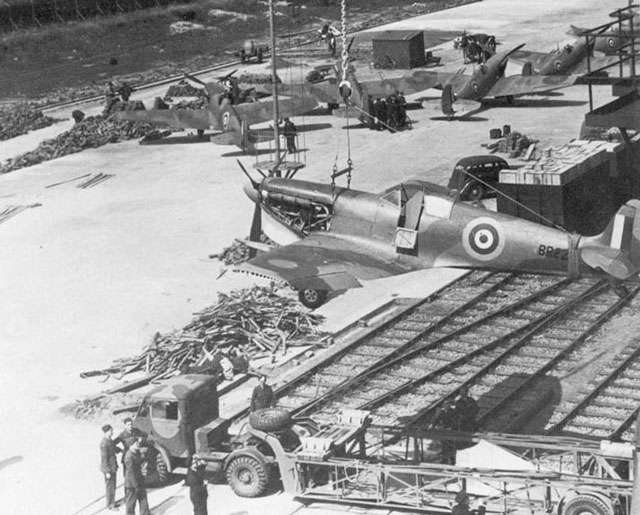
Now for my very unscientific assumptions (Couldn’t get away over the
holidays to either the British or American archives!). Given the way the
Spitfires seemed to be hastily painted, I believe that the decision to
paint them a dark color came while Wasp was at sea. With this assumption
on my part, and the fact that they were not painted prior to loading, I do
not believe stores of paint such as Extra Dark Sea Gray were loaded aboard
Wasp. If this was the case, what paints would have been used to repaint
them?
In 1941 Wasp had its camouflage changed from an overall “Black Scheme”,
“Scheme 4”, to a “Modified 12 Scheme”, which involved the use of Blue
(either Sea Blue 5-S or Navy Blue 5-N, and on Wasp I believe, but cannot
verify, that 5-N was used) and Gray on the vertical surface and Deck blue
20-B on the horizontal surfaces. The pictures of Wasp during Calendar do
seem to show a two color scheme that appears to be new. (Note: What is odd
is that the picture of Wasp does not show the splotchy camouflage of Mod.
12, but rather a segmented camouflage pattern.) I would presume that Wasp
would have sailed with stores of the new camouflage paint for subsequent
repairs. It could be argued that the use of ship paint is out of the
question, because it is too thick. But given that paint is nothing more
than pigment and carrier (thinner, etc.), the weight of the paint can be
reduced by the addition of more thinner. As modelers, we do this all the
time; Windsor Newton oils in tubes become a wash with the addition of
turpentine. I have even thinned oil based house paint to a wash so that
wood grain still shows through.
The question becomes, assuming that a shipboard blue was used, because
there are references to a blue, which blue was it (Now, if a dark gray
Ocean Gray 5-O was used, then oh well, project over!!). I believe that
both blues were used – Navy Blue 5-N and Deck Blue 20-B.
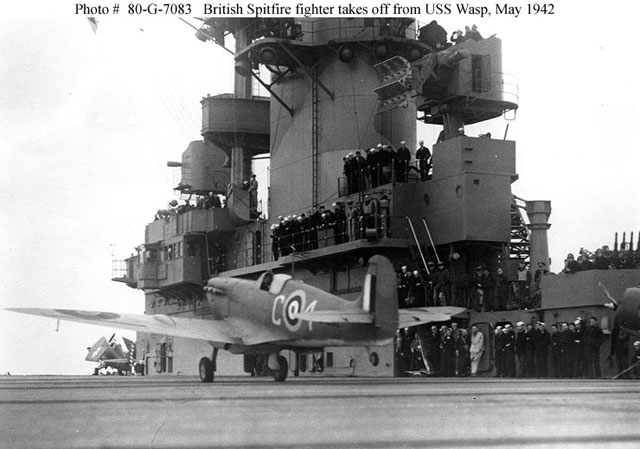
Click the
thumbnails below to view larger images:
The reason I believe both blues were used is because
Deck Blue 20-B is a very dark blue color, and in my opinion it would be
close in color to the Navy Blue of a uniform. Yet, the pictures of
Spitfires coded U*2 or C*4, seem to show these aircraft are lighter than
the uniforms on the sailors. In other pictures the Spitfires appear almost
black. I also do not believe that USN Blue-Gray was used, as it appears to
be too light. I know black and white picture are unreliable, and that
there is shifting light, and so on. As I said earlier, these are very
unscientific assumptions.
For the purpose of model paint comparison, I painted
the Tamiya scrap wing with Aeromaster USN Blue-Gray, Polly Scale Deck Blue
20-B, and Navy Blue 5-N. No paint was lightened or darkened in the
painting process.

I wanted to do Spitfire Mk. Vc BR124 / U*2. I started with the Tamiya Mk.
V Spitfire and the Bringuier Aviation Products Mk. Vc resin wings. (Shame
they are OOP, very nice, fit perfectly, just some minor warping.) I first
painted it Dark Earth, Middle Stone ( B scheme) and Sky Blue. For the Sky
Blue I used Polly Scale RAAF Sky Blue with some dark blue added. I then
applied the serial number. After masking the serial I sprayed the model
with Polly Scale Navy Blue 5-N. I did not even attempt the uneven
application that was on the original aircraft, although I did hand paint
around the fuselage roundel. I also applied a lighter spray on the rudder
and elevators, this was noticeable on the real aircraft, to reduce the
effect of paint on control surfaces.
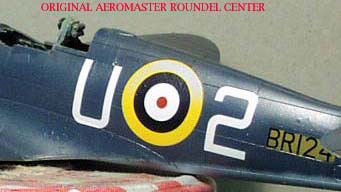 For
the markings for U*2, I used Aeromaster’s Defenders of Malta, Part I,
48-597. With respect to U*2, what a disappointment! The transit codes
(which were applied on Wasp) are too big by at least four to six inches.
Also, the red center of the fuselage roundel seems far too small. I found
a more appropriate red center, but could do nothing about the codes. The
instructions also indicate the Desert Scheme formed an outline around the
upper wing roundel. I have serious doubts about this. I have not seen this
on other pictures of dark painted Spitfires. For
the markings for U*2, I used Aeromaster’s Defenders of Malta, Part I,
48-597. With respect to U*2, what a disappointment! The transit codes
(which were applied on Wasp) are too big by at least four to six inches.
Also, the red center of the fuselage roundel seems far too small. I found
a more appropriate red center, but could do nothing about the codes. The
instructions also indicate the Desert Scheme formed an outline around the
upper wing roundel. I have serious doubts about this. I have not seen this
on other pictures of dark painted Spitfires.
There are also some odd issues to consider. For
example the color of the spinner. This is another assumption. It does not
look as black as the prop blades, and in the picture of the aircraft being
loaded on Wasp, it does not look like Dark Earth. I made an assumption of
dark red. There is also a very unique item that has been overlooked. There
appears to be chalked script on the cowl under the exhaust. It is not
legible. Could it be a good luck message, the signature of the painter of
the aircraft, or a pithy saying? No idea. I tried to represent this using
a squiggle of white paint on a fine brush. The antenna mast is another
matter. The picture of U*2 leaves me with the impression that it was left
unpainted in Middle Stone. U*2 also seems to have the attachment points
for the “cheese cutter” IFF wires, but they do not seem to have been
attached.
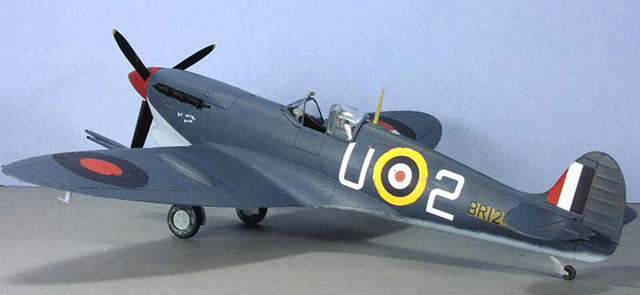
Finally I have one question for which I have no answer. If you look at the
wheels of U*2, the tires appear to have a bit of overspray. Also, some
Spitfires seem to have the light color extended across the bottom of the
rudder, and to me it appears the underside color is higher up than usual.
Could there have been full underside repainting en-route?

I could be so very, very wrong in my assumptions and conclusions. But, for
me, it really does not matter. I enjoyed the research and modeling
process. If nothing else, I have me one interestingly colored Spitfire. Of
course, I welcome comments and any information you wish to share.
I’d like to thank Graham Boak and David Wadman, who good naturedly put up
with my insanity and provided information that was not available to me,
and, of course, their opinions.
Spitfire Mark V Aces; Dr. Alfred Price, Osprey ,
1997.
http://www.geocities.com/Pentagon/Quarters/4289/Camo.html
http://www.steelnavy.com/usnchips.htm
http://www.modelwarships.com/reviews/books-plans/snyder-short/usn-1/usn-1.html
The Picture of the Spitfires being loaded is from The
Spitfire at War, by Dr. A Price.
The origins of the other picture is unknown to me, and will be removed at
the copyright holders request
Model, Images and Text Copyright © 2004
by Steven "Modeldad" Eisenman
except as noted above
Page Created 08 January, 2004
Last Updated
17 March, 2004
Back to
HyperScale Main Page |
Home |
What's New |
Features |
Gallery |
Reviews |
Reference |
Forum |
Search